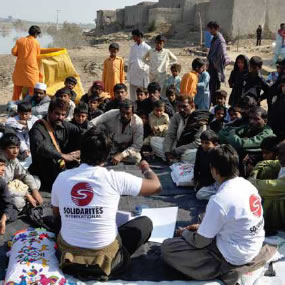
SOLIDARITÉS INTERNATIONAL’s objective, beyond traditional emergency aid, is to reduce the vulnerability of the populations. Indeed, populations must be included in a wider framework which incorporates a clear understanding of their livelihoods, including community members’ know-how, state of health, and intellectual and physical capacity, along with production capacity and other available assets.
Livelihoods are directly linked to individuals, to the resources they have, and to the activities they undertake to provide for their vital needs. Livelihoods must be understood in a way that takes into account the political, economic, and socio-cultural context.
The livelihoods approach is implemented throughout the duration of the project cycle. From the assessment phase onwards, analysis of livelihoods enables us to:
- Identify the risks which populations face in order to identify and define the different types of vulnerability, and the capacities for adaptation which are in place.
- Identify the geographical regions with the highest risk of food insecurity, pinpointing the most vulnerable sub-groups and the reasons for their vulnerability.
- Understand the adaptation strategies (both sustainable and unsustainable) employed in each situation.
- Anticipate the potential negative impact of a program and determine any external constraints that could limit its effectiveness or diminish its impact.
Livelihoods analysis includes a macro aspect (context analysis) and a micro aspect (analysis at household level). Vulnerability to food insecurity or water-related disease is classified according to the physical, socio-political and economic environment. These will vary according to household assets. It is also important to understand the different factors which mean that vulnerability to food insecurity can change over time. It is essential to collect information relative to the context (pre-crisis situation and the current situation, local WASH-related regulations, vulnerabilities, etc.), to the populations (socioeconomic and cultural constraints, habits, expectations, needs, local skills, etc.), and to the environment (water resources, geology, sources of pollution, etc.) of the area being assessed. The participation of target populations as well as all actors taking part in the needs assessment is essential, (local authorities, NGOs active in the region, health and education officials, and entities involved in water, hygiene and sanitation management, etc.).
